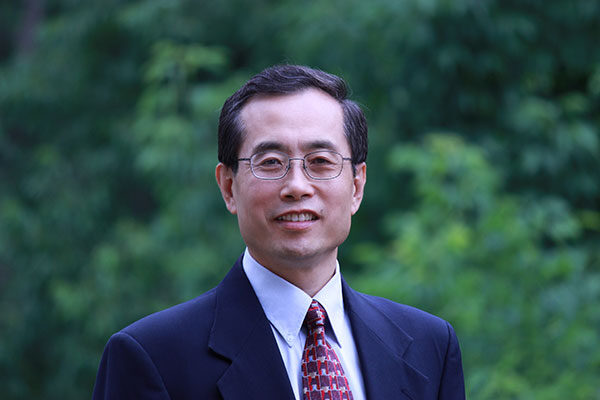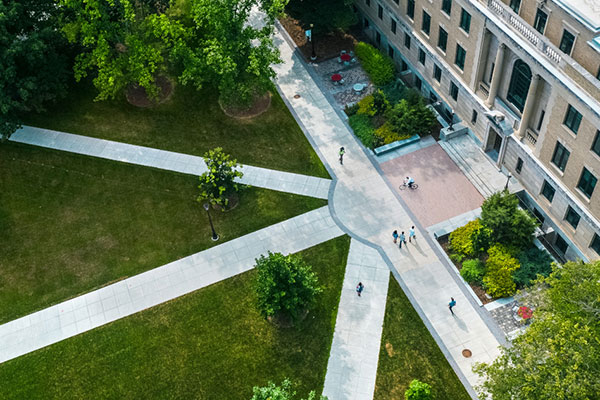Meet Jinhua Zhao, Dyson’s new dean

Jinhua Zhao, the David J. Nolan Dean of the Charles H. Dyson School of Applied Economics and Management
Jinhua Zhao, who was appointed the David J. Nolan Dean of the Charles H. Dyson School of Applied Economics and Management beginning July 1, has a contagious enthusiasm for Dyson’s future and is thoroughly confident in the school’s upward trajectory. An advocate for cross-disciplinary research that addresses social problems in innovative ways, Zhao believes Dyson is positioned to push the frontiers of business education to address 21st century challenges and to train future business leaders who will lead change and impact society in positive ways.
Before coming to Cornell, Zhao was a professor of economics at Michigan State University, where he also served as director of Michigan State’s Environmental Science and Policy Program, 2010-18. “Jinhua is a top-notch scholar, has an excellent track record as an administrator, and radiates excitement about Dyson’s incumbent strengths,” said Andrew Karolyi, dean of the Cornell SC Johnson College of Business in an announcement of Zhao’s appointment. “I believe that he has the expertise and energy to be a great leader for Dyson and to collaborate across our college and across Cornell.” Since Dyson is a shared school between the Cornell SC Johnson College of Business and the College of Agriculture and Life Sciences (CALS), Zhao reports both to Karolyi and to Benjamin Z. Houlton, the Ronald P. Lynch Dean of CALS.
Zhao’s research is focused on environmental and resource economics, with special interests in global climate change, renewable energies, water, and technology adoption. He also has research interests in China’s environment, including government regulation, firm and individual behavior, and payment for ecosystem services. He received his bachelor’s degree in industrial engineering from the University of Science and Technology Beijing in China, his master of science degree in agricultural economics from the University of Guelph in Canada, and his PhD in agricultural and resource economics from the University of California at Berkeley.
From his enthusiasm for cross-disciplinary collaboration and deep appreciation for the benefits of working together with people who are diverse in multiple ways to his research about pollution, policy, and the environment and his role as an advisor to the Environmental Protection Agency, Zhao shares what’s most important to him and why in this Q&A.
You held a joint appointment as a professor in the Department of Economics and in the Department of Agricultural, Food and Resource Economics at Michigan State University, 2010 – 2021. What similarities do you see between that academic environment and Dyson?
I worked with individuals within and across both departments at Michigan State University in a collaborative environment. Dyson, as a close knit community, is also highly collaborative. Moreover, we are seeing increasing collaboration in research, teaching, and services across the three schools in the SC Johnson College of Business.
Dyson is also similar in that it’s collegial. I’ve talked to so many people here who are helping me climb the learning curve. The incredibly supportive environment at Dyson makes it feel very much like a big family.
Cornell is an Ivy League university with a land grant mission. I’ve spent my career in land grant universities, and always appreciated the idea of faculty members and researchers working together to push the frontiers, generate new knowledge, and then engage with society to make the world a better place.
What inspired you to take on the role as dean of Dyson?
Dyson’s upward trajectory over the past several years shows extremely strong momentum. Looking at our undergraduate and graduate programs, the strength of our faculty, and the engagement with businesses and society, I’m incredibly optimistic and upbeat about Dyson’s future.
Being part of the SC Johnson College of Business, with its strong historical ties to CALS, puts Dyson in a uniquely strong position of being a leader in business education. Think about the major challenges we’re facing today, from climate change to inequality to polarization. Society is calling on higher education institutions to prepare leaders who can address these challenges and effect positive change. Dyson’s unique institutional setting provides our students with exposure to 21st century problems and the capacity to address them. For example, Dyson’s Grand Challenges program inspires and empowers our students to use their business skills to make a difference. Our ties to CALS are going to become even stronger, given where we want to go in shaping business education.
Dyson’s people are our strongest asset: stellar faculty and staff, exceptional students, incredible alumni. The caliber of people at Dyson ensures its upward trajectory. The more I learn about Dyson, about the SC Johnson College and CALS, and about Cornell, the more confident I am about Dyson’s future.

You worked to increase the diversity of the student body, faculty, and research areas at Michigan State University. How do you define diversity and will this be a priority for you at Dyson?
To me, diversity has multiple dimensions: in race, in socioeconomic status, in gender identity, in cultural backgrounds, in perspectives.
Diversity is going to be a priority at Dyson. Diversity is especially valuable in higher education because we are in the business of generating ideas, expanding frontiers, and training future leaders. Individuals from diverse backgrounds bring different ideas, and it’s through the exchange of different ideas, through inclusion and collaboration, that new ideas are generated and frontiers are expanded.
For example, through MSU’s WaterCube program, we brought together water researchers from diverse disciplines with very different perspectives and methodologies. But these differences not only increased our understanding about water issues, they also helped generate new knowledge and provide scientifically sound practical solutions that can bring about actual changes to society.
You directed Michigan State University’s Environmental Science and Policy Program (ESPP) for eight years. What drew you to that position and what were your priorities and key achievements ?
ESPP was created as a university-wide, horizontal organization to connect different environmental researchers and students across disciplines and enable them to work together. I was drawn to its mission of promoting interdisciplinary collaboration. At ESPP, we made institutional innovations to lower the barriers and transaction costs of collaboration. We created education programs that emphasized service learning and engagement with environmental policies. We introduced a number of interdisciplinary, team-building initiatives to connect researchers at varying stages of their career. In the WaterCube program, we designed a marketplace to have a bottom-up system of seed funding and incentivized peer review. These efforts greatly helped promote interdisciplinary research at MSU.
You served the Environmental Protection Agency for many years, nine on the Science Advisory Board’s Environmental Economics Advisory Committee (2009 – 2018) and two on the Board of Scientific Counselors’ Air, Climate and Energy Subcommittee (2015 – 2017). What was it like? Is it important for academic researchers to lend their expertise to policy development?
We talked about our land grant mission of outreach. Public engagement with government agencies such as the EPA is one way of carrying out that mission. It helps turn our knowledge, expertise and research findings towards making societal impacts.
We were also engaging with a diverse set of people, including those outside of academia, to think collectively and creatively. Members of the Board of Scientific Counselors’ Air, Climate and Energy Subcommittee came not only from different disciplines, but from different sectors: educational institutions, industry, NGOs. In one study, we advised the EPA on their approach to bringing social science into their research. We deliberated the many ways in which social science can help the EPA communicate their findings for societal impact, how the EPA could better engage communities in air-quality monitoring, and the best practices in interdisciplinary environmental research. I very much enjoyed both the process and the outcomes from that study.
How did your work at the EPA impact your perspective and outlook on the role and impact of policy?
Through participating in the EPA’s policy-making process, I came away with a better appreciation of the importance and feasibility of science-based policy. When we conduct research, especially applied research, we often emphasize its policy relevance and the messages for policy makers, but stop short of seeing the actual policy impacts. My experience at the EPA showed me that it is feasible to base major, national policies on the latest scientific findings, and applied researchers should always keep in mind that their research findings do impact actual policies.
Your research has focused on natural resource and environmental economics, with special interests in global climate change, renewable energies, and technology adoption. Why are these topics important to you?
I did not start out as an environmental economist; my undergraduate training in China was in industrial engineering. Later on, when I came first to Canada and then to the US, I started to study economics and how economic activities and public policies could impact social welfare. I was then drawn to environmental and resource economics because of its emphasis on social responsibility and externalities, and the long-term impacts of our current actions. Some of the biggest challenges facing human society today are environmental, and these include not only global climate change but also water and biodiversity. The solutions are also multi-faceted, including renewable energies and adoption of new technologies such as precision technologies. I am excited to work on these problems.
What are you focusing on in your current research?
In an ongoing project, we are studying the adoption of new irrigation technologies and new water-use institutions as adaptation strategies to climate change in the Great Plains region of the US. With declining availability of irrigation water, farmers in that region adopted more efficient irrigation technologies, but this didn’t lead to reduced water use, since the new technologies caused more land to be irrigated. Institutional changes are needed to go together with new technologies and we are studying the role of water rights and voluntary water-use organizations.
I’ve always been interested in understanding and improving the environmental policies in China. In recent years, China enacted strict environmental regulations in order to reduce pollution and improve environmental quality. I am interested in understanding the impacts of these policies and how they worked or did not work. What are the intricate mechanisms through which the policy trickled down to influence individual behavior that actually brought about these environmental changes? I have several projects along these lines. For example, one of the projects looks at a specific environmental policy intended to control sulfur dioxide emissions. We found that the policy impacted the state-owned firms and non-state-owned firms very differently: State-owned enterprises could invest in emission abatement technologies because they had access to credit, but non-state-owned enterprises did not have access to credit, so the only way they could cut emissions was to reduce their output.
How would you characterize your leadership style?
What defines me and my leadership style is collaboration. I’m a strong believer in collective excellence: When we come together and collaborate, each of our unique perspectives will become assets. I also believe in transparency, not only for efficient information flow but also for serving as a mechanism to bring people together. Through transparency, we can bridge differences to bring about greater value.
What is the absolute best, most satisfying thing about the work you do?
What gets me up in the morning, what gets me excited, is new ideas—new ideas about research, about how to make a positive impact, about our education programs, about how we can create better student experiences. I’m really fortunate to work in a top-notch university like Cornell, a powerhouse in innovation, a place where I’m surrounded by people who have new ideas. I find the process of generating new ideas, turning them into action, and seeing the benefits very satisfying.
What book, person, or experience has had the biggest impact on your life?
I would say it’s my father. He lived through some of the most turbulent years in China, experienced a lot, and overcame many difficulties. He was always positive, humble, and ready to help others. He instilled those values in our family. He liked to tell us about his experiences, often matter-of-factly. That kind of exposure influenced me a lot and shaped me early on.
Sometimes, when I am in a difficult situation, I look at what he experienced and I know, “This is peanuts; it’s nothing.”
What do you do to recharge?
I enjoy working out, which gets me re-energized. My wife and I are also into hiking; it’s a great way to recharge and to spend time with family.
You moved to Ithaca in early August. Did your family move here, too? What is your impression so far?
Yes, my family is here, and my wife and I have already started exploring the hiking trails in Ithaca. We’ve hiked the trails in Sapsucker Woods close to the Cornell Lab of Ornithology, the Cascadilla Gorge trail next to the campus, and the Cayuga Waterfront Trail. We have always enjoyed nature together, and we still have so much to explore in this area. My wife gets excited when she finds out about a new trail. The campus is also beautiful—we’ve walked around to see the arboretum and waterfalls. For nature lovers like us, Ithaca is perfect.


Comments